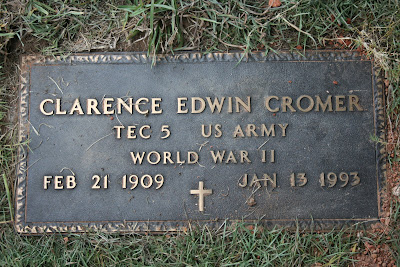
Bernard Hendrick White (1866-1947)
In 1911, Bernard and Lula May welcomed their tenth child (the seventh daughter) named Elizabeth. Elizabeth was a bright child, excelling in school and after Kanawha City High School, she proceeded to Capitol City Commercial College in Charleston, WV. She worked as a stenographer for a local wholesale dry goods company until the early 1930s.
 Elizabeth White, c.1930's
Elizabeth White, c.1930's
One of Elizabeth’s older sisters, Evelyn, was engaged to a charming young man named Bill. He was from South Carolina, and on one of his many trips to visit his girlfriend/fiancée/future wife, he brought one of his younger brothers, Ed, along for the ride.

Ed Cromer, c. 1930
At the time, Ed had a girlfriend, and Elizabeth was engaged, but their hearts must not have been totally invested, for they soon found themselves emotionally attached to each other. (Later, Elizabeth would say of her former fiancée, “On some of our dates, I would read a book or magazine or even take a nap while my boyfriend worked a jigsaw puzzle with my sister Gail”). Soon thereafter, Ed and Elizabeth were engaged.

The happily-engaged couple.
They were married on June 22, 1936, in a ceremony performed by Elizabeth’s Uncle Charlie (Charles A. Slaughter, minister in the Southern Methodist church) in Barboursville, West Virginia.

Wedding Day: June 22, 1936.

Ed & Elizabeth, with her Uncle Charlie Slaughter relaxing in the background.
Elizabeth left her home and family to begin a new life in South Carolina. She and her husband opened a grocery store, and by the early 1940’s, their family had expanded to include both a daughter and a son.
 Elizabeth, Carolyn & Steve
Elizabeth, Carolyn & Steve
In the 1940’s, the United States was deeply involved in World War II, fighting a war in both the Europe and the South Pacific. It was a time of personal and national sacrifice, and in 1944, Ed left his pregnant wife, his daughter and his son to attend basic training at Fort Leonard Wood, Missouri. After completion, Ed served with the Signal Corp in Europe, spending time in both England and Germany. In 1946, he returned home to Elizabeth and his youngest son (now 3 years old) that he had never seen.

Ed, 1944
 Easter, 1962
Easter, 1962The years passed, and the kids grew, and left home, and married other young adults and proceeded to give Ed & Elizabeth six grandchildren. Ed retired and closed the grocery store in 1974 and they enjoyed the golden years of their life.
 Christmas, 1991
Christmas, 1991In 1993, after 57 years of marriage, Ed passed away. Fifteen years later, on August 22, 2008, Elizabeth followed him into the afterlife.

You may have figured it out by now, but Ed and Elizabeth were my maternal grandparents (we called them Papa & Nana) , and I was fortunate to be able to spend my growing-up years in the same town as both my sets of grandparents.

Nana, 2008
Nana passed away last Saturday, at the ripe old age of 97, after a long and rewarding life. Some anonymous author in ages past wrote, ““From our ancestors come our names, but from our virtues, 0ur honor.” In this case, I’d disagree. Members of our family were lucky enough to get both from this virtuous, honorable woman and she made a lasting, positive impact on many people in her 97 years on this earth.
Nana was buried next to my grandfather in Spartanburg.








